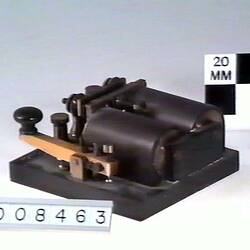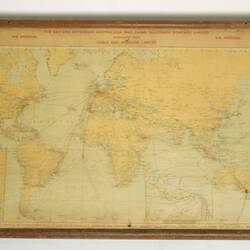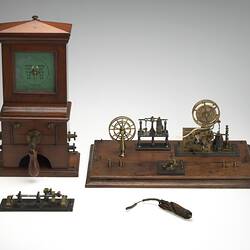Summary
Portable telegraph key and sounder. Used by personnel working on telegraph lines in the field to transmit and receive messages.
To transmit signals the operator depressed a pivoted metal lever (the key) to complete an electric circuit and transmit current along the telegraph line. Releasing the key broke the circuit and cut off the current. Letters and numbers were represented by a sequence of short and long current pulses, transmitted according to a defined code. The most widely used code was generally known as "Morse code".
When receiving signals, the incoming current pulses energised the coils of the receiving instrument, or "sounder". The operator interpreted the signals by listening to the sounds made by the sounder mechanism.
Physical Description
Ebonite base. Straight brass key with ebonite knob. Two horizontal coils with ebonite covers. Brass screw terminals. Base fitted with small circular magnetic compass.
More Information
-
Collection Names
-
Collecting Areas
-
Acquisition Information
Purchase
-
Manufacturer
Siemens Bros Dynamo Works Ltd, London, England, Great Britain, 1865-1916
The Siemens organisation in the United Kingdom was renamed Siemens Brothers in 1865. -
Inscriptions
Base engraved: 'Siemens Bros. / London'
-
Classification
-
Category
-
Discipline
-
Type of item
-
Overall Dimensions
110 mm (Length), 96 mm (Width), 50 mm (Height)
-
Exhibition Collection Management
50 mm (Length), 95 mm (Width), 105 mm (Height)
-
Dimensions
104 mm (Length), 95 mm (Width), 55 mm (Height)
Measurement From Conservation. Measuring Method: Maximum dimensions
-
Keywords




